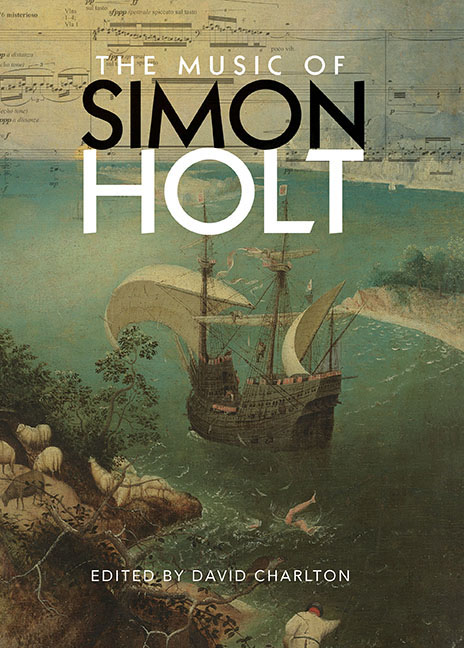Book contents
- Frontmatter
- Contents
- Figures and Tables
- Contributors
- Preface and Acknowledgements
- Abbreviations, with a note on recordings and scores
- Introduction Memories of Magical Moonlight: Simon Holt's years as a composition student
- 1 Duende y Duelos: The Andalusian spirit in the Lorca settings
- 2 An Interplay of Passion and Spirit: The Nightingale's to Blame
- 3 Images in Sound: Movement, harmony and colour in the early music
- 4 Myth and Narrative in 3 for Icarus
- 5 Sound, Sense and Syntax: The Emily Dickinson settings
- 6 Piano Music
- 7 Redefining the Cello's Voice: Musical agency in feet of clay
- 8 Performance and Reflections: Holt's music for oboe and cor anglais
- 9 Shaking the Bars: The Yellow Wallpaper
- 10 Listening to the River's Roar: Stance, texture and space in the concertos
- 11 Orchestral Works in Performance
- 12 Oblique Themes and Still Centres: A conversation between
- 13 Sketching and Idea-Gathering
- 14 Art, Conceptualism and Politics in Holt's music
- Appendix A Overview and Catalogue of Pieces
- Appendix B Texts by Simon Holt for Raju Raghuvanshi is a ghost and The Legend of Melusine
- Bibliography
- Index of pieces by Simon Holt
- General index
12 - Oblique Themes and Still Centres: A conversation between
Published online by Cambridge University Press: 01 September 2018
- Frontmatter
- Contents
- Figures and Tables
- Contributors
- Preface and Acknowledgements
- Abbreviations, with a note on recordings and scores
- Introduction Memories of Magical Moonlight: Simon Holt's years as a composition student
- 1 Duende y Duelos: The Andalusian spirit in the Lorca settings
- 2 An Interplay of Passion and Spirit: The Nightingale's to Blame
- 3 Images in Sound: Movement, harmony and colour in the early music
- 4 Myth and Narrative in 3 for Icarus
- 5 Sound, Sense and Syntax: The Emily Dickinson settings
- 6 Piano Music
- 7 Redefining the Cello's Voice: Musical agency in feet of clay
- 8 Performance and Reflections: Holt's music for oboe and cor anglais
- 9 Shaking the Bars: The Yellow Wallpaper
- 10 Listening to the River's Roar: Stance, texture and space in the concertos
- 11 Orchestral Works in Performance
- 12 Oblique Themes and Still Centres: A conversation between
- 13 Sketching and Idea-Gathering
- 14 Art, Conceptualism and Politics in Holt's music
- Appendix A Overview and Catalogue of Pieces
- Appendix B Texts by Simon Holt for Raju Raghuvanshi is a ghost and The Legend of Melusine
- Bibliography
- Index of pieces by Simon Holt
- General index
Summary
BACKGROUND INTRODUCTION
BETWEEN 1985 AND 1994 I worked as a director in theatre, opera, contemporary music and dance with my own company, as joint Artistic Director at the Leicester Haymarket and Young Vic Theatres, and on freelance projects. From 1994 onwards my work shifted to a more studio-based practice. I developed a visual language that integrated performance, film, video projection, photography, extreme garments, sculptural objects and installation. During 2003 the producer/director Cathie Boyd invited me to create the video projections, garments and visual staging elements for a new opera commissioned by Almeida Aldeburgh Opera, Who put Bella in the Wych elm? by Simon Holt. It was during the production period that Simon and I discovered a shared passion for the visual arts and started a dialogue about the nature of collaboration and the challenges of staging contemporary music.
Simon had developed Bella from a newspaper article about an unsolved murder case from 1943. A female body had been discovered hidden in the trunk of a tree by three boys bird-nesting in Hagley Wood. One hand was missing from the body and a piece of taffeta stuffed in the mouth. The story had mystery and intrigue, with implications of magic and the occult, combined with the mythic setting of the fairy-tale wood. The published libretto, which is by the composer, contains no specifications concerning its setting, staging or layout; the only sung roles are for Bella (dramatic soprano) and a Protagonist (baritone: ‘a man in his seventies, anonymous and unremarkable’). The Protagonist's ‘inner voice’ is also sung by the baritone. The two other dramatis personae are a Violinist and a Pianist, who walk on stage as if to give a concert, alongside the Protagonist who is their page-turner. He ‘appears as normal for the first four minutes or so’ but then begins to disrupt the ‘recital’.
- Type
- Chapter
- Information
- The Music of Simon Holt , pp. 243 - 260Publisher: Boydell & BrewerPrint publication year: 2017

